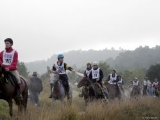
Endurance riding
Encyclopedia
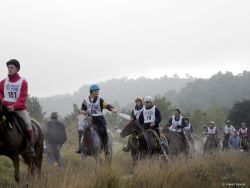
Equestrianism
Equestrianism more often known as riding, horseback riding or horse riding refers to the skill of riding, driving, or vaulting with horses...
sport based on controlled long-distance races. It is one of the international competitions recognized by the FEI
International Federation for Equestrian Sports
The Fédération Équestre Internationale or in English, the International Federation for Equestrian Sports, is the international governing body of equestrian sports. It recognizes ten international disciplines...
. There are endurance rides worldwide.
There are two main types of long-distance riding, competitive trail riding
Competitive trail riding
Competitive Trail Riding is an equestrian sport where riders cover a marked trail for a distance that is usually between 15 and 40 miles per day. Some rides are only one day long, others may run as long as three days....
and endurance rides. In an endurance ride, discussed in this article, the winning horse is the first one to cross the finish line while stopping periodically to pass a veterinary
Veterinary medicine
Veterinary Medicine is the branch of science that deals with the prevention, diagnosis and treatment of disease, disorder and injury in non-human animals...
check that deems the animal in good health and fit to continue. In the United States, most endurance rides are either 50 or 100 miles (160.9 km) long. Shorter rides, called Limited Distance Competition, are organized for new riders to the sport or young horses being trained. There are also a few longer, usually multi-day, rides run as well. As with human marathon running, many riders will participate to improve their horse's personal best performance and consider finishing the distance with a proper vet completion record to be a "win". In the USA, the American Endurance Ride Conference (AERC) sanctions endurance rides. In the UK, Endurance GB is the governing body. Winning riders complete 100 miles (160.9 km) rides in 10-12 hours.
Any breed can compete, but the Arabian
Arabian horse
The Arabian or Arab horse is a breed of horse that originated on the Arabian Peninsula. With a distinctive head shape and high tail carriage, the Arabian is one of the most easily recognizable horse breeds in the world. It is also one of the oldest breeds, with archaeological evidence of horses...
generally dominates the top levels because of the breed's stamina and natural endurance abilities.
Competitive trail rides are shorter, and factors other than speed are considered; horses may not come in under or over a certain time, and veterinary checks, rider behavior and other elements play a role in the placings. (See Competitive trail riding
Competitive trail riding
Competitive Trail Riding is an equestrian sport where riders cover a marked trail for a distance that is usually between 15 and 40 miles per day. Some rides are only one day long, others may run as long as three days....
.)
Worldwide, rules vary. Endurance rides and races can be any distance, though they are rarely over 160 km for a one-day competition.
History
Though the need to ride long distances has existed since the domestication of the horseDomestication of the horse
There are a number of hypotheses on many of the key issues regarding the domestication of the horse. Although horses appeared in Paleolithic cave art as early as 30,000 BCE, these were truly wild horses and were probably hunted for meat. How and when horses became domesticated is disputed...
, endurance riding as an organized activity was first developed in the United States
United States
The United States of America is a federal constitutional republic comprising fifty states and a federal district...
based on European cavalry (particularly Polish and Russian WWI) and breeding program tests requiring the ability to carry 300 lb (136.1 kg) over 100 miles (160.9 km) in one day. Organized endurance riding as a formal sport began in 1955, when Wendell Robie and a group of equestrians rode from the Lake Tahoe area across the Sierra Nevada Range to Auburn in under 24 hours. They followed the historic Western States Trail. This ride soon became known as the Tevis Cup
Tevis Cup
The Western States Trail Ride, popularly called The Tevis Cup, is a 100-mile endurance ride. The amateur event has been held annually since 1955....
, and it remains the most difficult of any 100-mile ride in the world because of the severe terrain, high altitude, and 100-degree temperatures. Endurance riding first was brought to Europe in the 1960s.
Structure of the ride
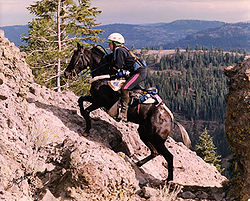
The ride is divided into sections, with different names (legs, phases, etc.), depending on sanctioning organization. After each phase, horses are stopped for a veterinary inspection
Veterinary medicine
Veterinary Medicine is the branch of science that deals with the prevention, diagnosis and treatment of disease, disorder and injury in non-human animals...
(sometimes called a "vetgate"), where they are checked for soundness and dehydration
Dehydration
In physiology and medicine, dehydration is defined as the excessive loss of body fluid. It is literally the removal of water from an object; however, in physiological terms, it entails a deficiency of fluid within an organism...
, with their pulse and respiration taken. To continue the ride, the horse must pass the examination, including reducing its heart rate
Circulatory system of the horse
The circulatory system of the horse consists of the heart, the blood vessels, and the blood.-The heart:The equine heart is made of muscle tissue, more rounded in shape than a human's, built with the sole purpose of pumping blood throughout the body...
below that specified for the event, typically 64 bpm, although terrain and weather may require the ride veterinarians to set a different maximum target. The riders' time keeps running until their horses reach the required target, so it is important that the horses recover as soon as possible. Any horse deemed unfit to continue (due to lameness or excessive fatigue, for example) is eliminated from further competition.
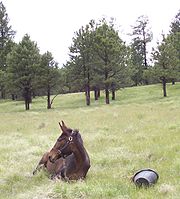
Riders are free to choose their pace during the competition, adjusting to the terrain and their mount's condition. Therefore, they must have a great knowledge of pace, knowing when to slow down or speed up during the ride, as well as a great knowledge of their horse's condition and signs of tiring. Riders may also choose to ride, or may dismount and walk or jog with their horse without penalty. However, they must be mounted when they cross the starting and finish lines.
The terrain riders compete over varies greatly from ride to ride. However, natural obstacles (called "hazards"), are marked on the trails with red flags on the right and white flags on the left. When so marked, riders must pass through the flags. In some areas, wilderness or undeveloped areas are difficult to find; in these places, no more than 10% of the route can be on hard-surfaced roads.
Determining the winner
Under the rules of the FEI and AERC, the first horse to cross the line and pass the vet check as "fit to continue" is the winner. Under the rules of competitive trail ridingCompetitive trail riding
Competitive Trail Riding is an equestrian sport where riders cover a marked trail for a distance that is usually between 15 and 40 miles per day. Some rides are only one day long, others may run as long as three days....
and the endurance rules in some nations (though not international competition nor that in the USA), as well as for limited-distance endurance rides (25-49 miles or 40-79 km in one day), the winner is determined by a combination of speed and the recovery rate of the horse or by a required standard.
Additional awards are usually given to the best-conditioned horses who finish in the top 10 for distances of 50 miles (80.5 km) or more. The Best Conditioned, or "BC" award is generally more prized than finishing first, as it is determined by a combination of speed, weight carried, and veterinary scores. Thus, a horse finishing fourth, but carrying a heavier rider than the first place finisher and with equal vet scores, still has a good chance to win the BC award.
Domestic and international competition
Endurance became a recognized FEIInternational Federation for Equestrian Sports
The Fédération Équestre Internationale or in English, the International Federation for Equestrian Sports, is the international governing body of equestrian sports. It recognizes ten international disciplines...
discipline in 1982, and the international organization has since set down rules with the welfare of the horse as top priority. In the United States, endurance rides are sanctioned by the FEI, the AERC, or both but never the FEI alone. When both the FEI and AERC sanction a ride, the FEI rules prevail.
Two well-known American 100 miles (160.9 km) endurance rides are The Western States Trail Ride, commonly known as the Tevis Cup
Tevis Cup
The Western States Trail Ride, popularly called The Tevis Cup, is a 100-mile endurance ride. The amateur event has been held annually since 1955....
, held in California, and the Old Dominion ride, held in Virginia. Additionally, the top riders and horses compete at the World Equestrian Games
World Equestrian Games
The FEI World Equestrian Games are the major international championships for equestrianism, and administered by the Fédération Equestre Internationale . The games have been held every four years, halfway between sets of consecutive Summer Olympic Games, since 1990...
, the Endurance World Championships, and the European Endurance Championships.
One-day international competitions are 40-160 km. Multi-day competitions are longer but have daily distance limits. Those that are FEI recognized and are broken into the following categories:
- CEI * (one star): minimum average distance each day is 40-79 km
- CEI **: 80-119 km minimum average distance each day
- CEI ***: 120+ km minimum average distance each day
- CEI ****: usually 160 km, with the winners completing in 10-12 hours
Note: CEI is the notation that the competition is an FEI-approved international competition.
When first recognized by the FEI, there were only four international competitions. This grew to an average of 18 rides per year by 1998, when the first World Championships were held in the United Arab Emirates
United Arab Emirates
The United Arab Emirates, abbreviated as the UAE, or shortened to "the Emirates", is a state situated in the southeast of the Arabian Peninsula in Western Asia on the Persian Gulf, bordering Oman, and Saudi Arabia, and sharing sea borders with Iraq, Kuwait, Bahrain, Qatar, and Iran.The UAE is a...
. The World Championships provided a huge boost to the sport, and, by 2005, there were 353 international competitions, second to only eventing
Eventing
Eventing is an equestrian event comprising dressage, cross-country, and show jumping. This event has its roots in a comprehensive cavalry test requiring mastery of several types of riding...
and show jumping
Show jumping
Show jumping, also known as "stadium jumping," "open jumping," or "jumpers," is a member of a family of English riding equestrian events that also includes dressage, eventing, hunters, and equitation. Jumping classes commonly are seen at horse shows throughout the world, including the Olympics...
. Due to the huge increase in international competition, endurance is growing quite rapidly worldwide.
Equipment
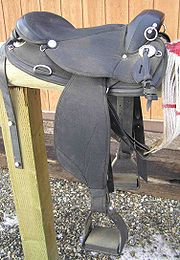
An equestrian helmet is required for nearly all sanctioned rides, including the AERC and FEI. At FEI competitions, riders must wear riding breeches or riding tights, correct footwear, and a shirt with a collar.
Endurance riders usually use a specialized saddle
Saddle
A saddle is a supportive structure for a rider or other load, fastened to an animal's back by a girth. The most common type is the equestrian saddle designed for a horse, but specialized saddles have been created for camels and other creatures...
that is designed to be lightweight yet comfortable to horse and rider for long hours of riding. At the highest levels, it is usually a variation on the English saddle
English saddle
English saddles are used to ride horses in English riding disciplines throughout the world. The discipline is not limited to England or English-speaking countries. This style of saddle is used in all of the Olympic and FEI equestrian disciplines, except for the newly-approved FEI events of...
in shape, although it may have wider panels and stirrups with a wider tread. Regardless of design, endurance saddles are very light to ensure the horse does not have to carry unnecessary weight. Many endurance saddles have extra metal rings for the attachment of equipment. At lower levels, lightweight endurance designs based on western saddle
Western saddle
Western saddles are used for western riding and are the saddles used on working horses on cattle ranches throughout the United States, particularly in the west. They are the "cowboy" saddles familiar to movie viewers, rodeo fans, and those who have gone on trail rides at guest ranches...
s are popular. Various experimental designs are also common, including treeless and flexible panel saddles.
Riders who compete in CEI rides must meet a minimum weight of 75 kg with their saddle. If the rider weighs in under 75 kg, they are required to ride with weights. Weigh-ins are generally conducted before and after a race; however, unscheduled weigh-ins can occur during the race.
Bridle
Bridle
A bridle is a piece of equipment used to direct a horse. As defined in the Oxford English Dictionary, the "bridle" includes both the headstall that holds a bit that goes in the mouth of a horse, and the reins that are attached to the bit....
s for the horses may use a wide variety of bits
Bit (horse)
A bit is a type of horse tack used in equestrian activities, usually made of metal or a synthetic material, and is placed in the mouth of a horse or other equid and assists a rider in communicating with the animal. It rests on the bars of the mouth in an interdental region where there are no teeth...
or hackamore
Hackamore
A hackamore is a type of animal headgear which does not have a bit. Instead, it has a special type of noseband that works on pressure points on the face, nose, and chin...
s. Riders also often add a breastplate
Breastplate (tack)
A breastplate is a piece of riding equipment used on horses. Its purpose is to keep the saddle or harness from sliding back....
to keep the saddle in place while traveling over rough terrain. Use of a crupper
Crupper
A crupper is a piece of tack used on horses and other equids to keep a saddle, harness or other equipment from sliding forward.-Construction:...
is not common, but sometimes seen to keep the saddle from sliding forward on horses with a certain build. Protective boots may be used on a horse's legs, though boots also cause problems in some types of terrain (they may slip, can collect burrs and dirt, and if crossing water may become waterlogged, any of which can irritate the legs of the horse and lead to lameness), so use varies by the type of ride and the rider's preferences.
See also
- International Federation for Equestrian SportsInternational Federation for Equestrian SportsThe Fédération Équestre Internationale or in English, the International Federation for Equestrian Sports, is the international governing body of equestrian sports. It recognizes ten international disciplines...
- Trail ridingTrail ridingTrail riding sometimes called horse or pony trekking is riding outdoors on natural trails and roads as opposed to riding in an enclosed area such as a riding arena. The term may encompass those who travel on horses, on mountain bikes, or on motorcycles and other motorized all-terrain vehicles...
- Competitive trail ridingCompetitive trail ridingCompetitive Trail Riding is an equestrian sport where riders cover a marked trail for a distance that is usually between 15 and 40 miles per day. Some rides are only one day long, others may run as long as three days....
- EquestrianismEquestrianismEquestrianism more often known as riding, horseback riding or horse riding refers to the skill of riding, driving, or vaulting with horses...
- Hunter PacingHunter PacingA hunter pace is a form of competition involving horses and riders. In a hunter pace a trail is marked for horse and rider to follow. On the day of the competition, early in the morning, the hosts of the event send an experienced horse and rider to ride the trail as fast as it is safely possible to...
- Shahzada (horse race)Shahzada (horse race)The Shahzada Memorial Endurance Test is horse race that has been held annually at St. Albans, New South Wales, Australia since 1981.It is an endurance race, where competitors must complete a cross-country route....
External links
- Endurance GB The official UK endurance group
- American Endurance Ride Conference
- Equestrian Federation of Kazakhstan official website Russian - Equestrian Federation of Kazakhstan English
- Fédération Équestre Internationale (International Federation for Equestrian Sports)
- Official Czech endurance website
- Unofficial Slovak endurance website
- History of the Old Dominion Ride

